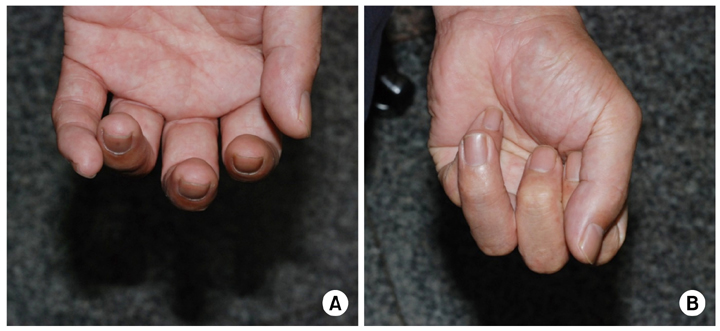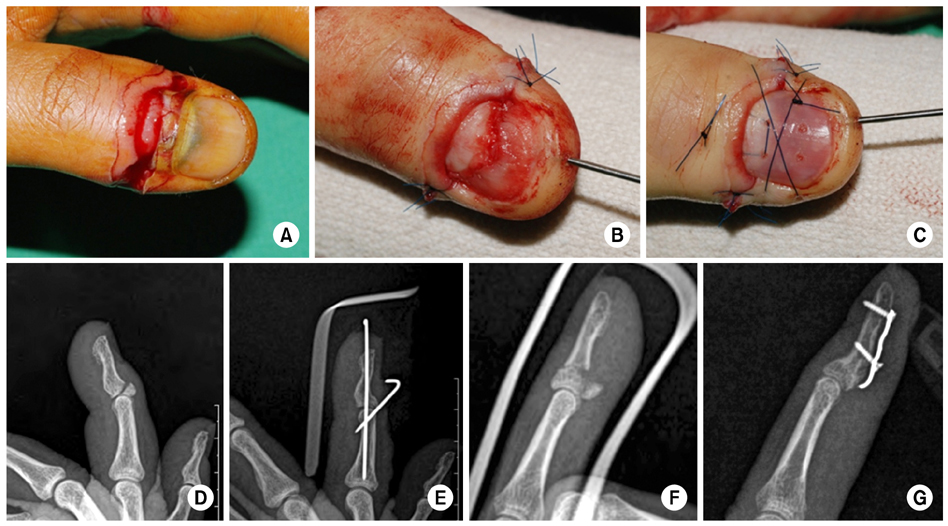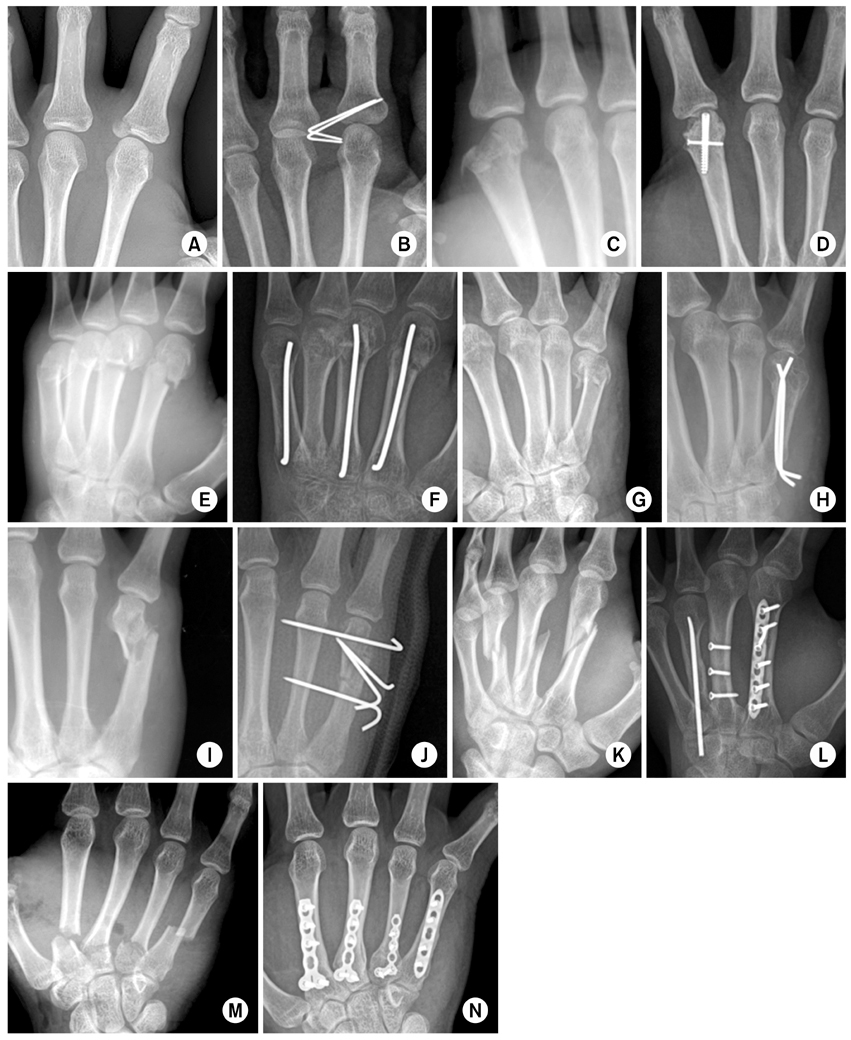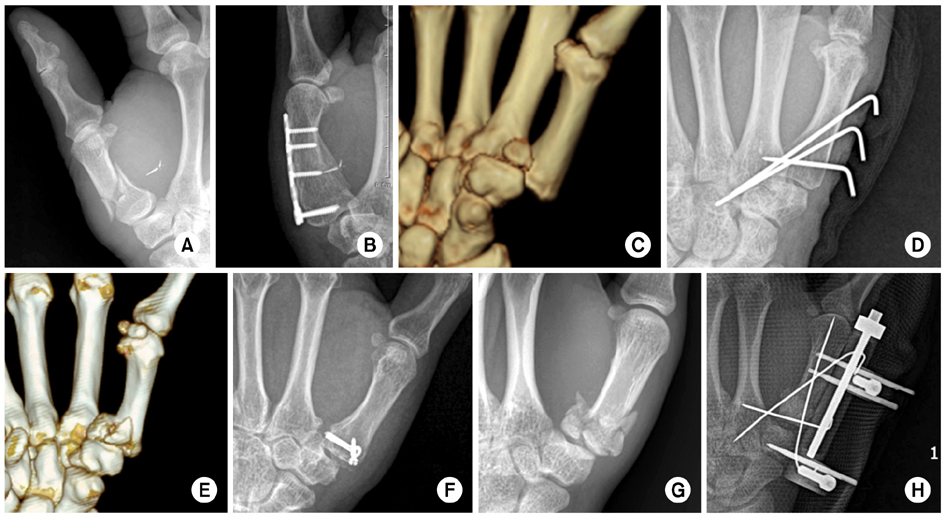J Korean Fract Soc.
2016 Apr;29(2):143-159. 10.12671/jkfs.2016.29.2.143.
Current Concepts of Fractures and Dislocation of the Hand
- Affiliations
-
- 1Gachon University Gil Hospital Trauma Center, Incheon, Korea.
- 2Department of Orthopaedic Surgery, Gachon University Gil Medical Center, Incheon, Korea. baekjr@gilhospital.com
- KMID: 2162017
- DOI: http://doi.org/10.12671/jkfs.2016.29.2.143
Abstract
- Fractures and dislocation of the hand is a body injury involving complex structures and multiple functions, which frequently occur as they represent 10%-30% of all fractures. Such fractures and dislocation of the hand should be treated in the context of stability and flexibility; and tailored treatment is required in order to achieve the most optimal functional performance in each patient since deformation may occur if not treated, stiffness may occur with unnecessarily excessive treatment, and both deformation and stiffness may occur coincidently with inappropriate treatment. Stable injuries can be fixed with splintage whereas surgery is actively considered for unstable injuries. In addition, surgeons should keep in mind that as the surgical intervention is done aggressively, aggressive rehabilitation must be followed in correspondence with the surgical intervention. Successful outcome requires effort to prevent any potential complication including nerve hypersensitivity and infection. Finally, it is also important that the patient to know that swelling, stiffness, and pain may last for a long period of time until the recovery of fractures and dislocation of the hand.
Keyword
Figure
Reference
-
1. Brunet ME, Haddad RJ Jr. Fractures and dislocations of the metacarpals and phalanges. Clin Sports Med. 1986; 5:773–781.2. Diwaker HN, Stothard J. The role of internal fixation in closed fractures of the proximal phalanges and metacarpals in adults. J Hand Surg Br. 1986; 11:103–108.
Article3. Court-Brown CM, Wood AM, Aitken S. The epidemiology of acute sports-related fractures in adults. Injury. 2008; 39:1365–1372.
Article4. Oetgen ME, Dodds SD. Non-operative treatment of common finger injuries. Curr Rev Musculoskelet Med. 2008; 1:97–102.
Article5. Singh J, Jain K, Mruthyunjaya , Ravishankar R. Outcome of closed proximal phalangeal fractures of the hand. Indian J Orthop. 2011; 45:432–438.
Article6. Yoong P, Goodwin RW, Chojnowski A. Phalangeal fractures of the hand. Clin Radiol. 2010; 65:773–780.
Article7. Chim H, Teoh LC, Yong FC. Open reduction and interfragmentary screw fixation for symptomatic nonunion of distal phalangeal fractures. J Hand Surg Eur Vol. 2008; 33:71–76.
Article8. Gaheer RS, Ferdinand RD. Fracture dislocation of carpometacarpal joints: a missed injury. Orthopedics. 2011; 34:399.
Article9. Meals C, Meals R. Hand fractures: a review of current treatment strategies. J Hand Surg Am. 2013; 38:quiz 1031. 1021–1031.
Article10. Tuncer S, Aksu N, Dilek H, Ozkan T, Hamzaoglu A. Fractures of the fingers missed or misdiagnosed on poorly positioned or poorly taken radiographs: a retrospective study. J Trauma. 2011; 71:649–655.
Article11. Federation of the European Societies for Surgery of the Hand 6th Congress Instructional Course. Fractures of the metacarpals and phalanges in adults and children. Bonn, Germany, 26-29 May 1999. Abstracts. J Hand Surg Br. 1999; 24:Suppl 1. 1–30.12. del Piñal F, Moraleda E, Rúas JS, de Piero GH, Cerezal L. Minimally invasive fixation of fractures of the phalanges and metacarpals with intramedullary cannulated headless compression screws. J Hand Surg Am. 2015; 40:692–700.
Article13. Le Nen D. Extra-articular fractures of the digital metacarpals and phalanges of the long fingers. Chir Main. 2014; 33:1–12.
Article14. Lautenbach M, Eisenschenk A, Sparmann M. Surgical and conservative treatment distal phalangeal fractures. Kongressbd Dtsch Ges Chir Kongr. 2002; 119:519–525.15. Ugurlar M, Saka G, Saglam N, Milcan A, Kurtulmus T, Akpınar F. Distal phalanx fracture in adults: Seymourtype fracture. J Hand Surg Eur Vol. 2014; 39:237–241.
Article16. Apic G, Mentzel M, Röhm A, Schöll H, Gülke J. Distal phalangeal fractures of the finger. Results of conservative and surgical treatment. Unfallchirurg. 2014; 117:533–538.17. Valdes K, Naughton N, Algar L. Conservative treatment of mallet finger: a systematic review. J Hand Ther. 2015; 28:237–245. quiz 246
Article18. Richards SD, Kumar G, Booth S, Naqui SZ, Murali SR. A model for the conservative management of mallet finger. J Hand Surg Br. 2004; 29:61–63.
Article19. Auchincloss JM. Mallet-finger injuries: a prospective, controlled trial of internal and external splintage. Hand. 1982; 14:168–173.
Article20. Geyman JP, Fink K, Sullivan SD. Conservative versus surgical treatment of mallet finger: a pooled quantitative literature evaluation. J Am Board Fam Pract. 1998; 11:382–390.
Article21. Horiuchi Y, Itoh Y, Sasaki T, Tasaki K, Iijima K, Uchinishi K. Dorsal dislocation of the D.I.P. joint with fracture of the volar base of the distal phalanx. J Hand Surg Br. 1989; 14:177–182.
Article22. Kapur B, Paniker J, Casaletto J. An alternative technique for external fixation of traumatic intra-articular fractures of proximal and middle phalanx. Tech Hand Up Extrem Surg. 2015; 19:163–167.
Article23. Hornbach EE, Cohen MS. Closed reduction and percutaneous pinning of fractures of the proximal phalanx. J Hand Surg Br. 2001; 26:45–49.
Article24. Oxford KL, Hildreth DH. Fracture bracing for proximal phalanx fractures. J Hand Ther. 1996; 9:404–405.
Article25. Figl M, Weninger P, Hofbauer M, Pezzei C, Schauer J, Leixnering M. Results of dynamic treatment of fractures of the proximal phalanx of the hand. J Trauma. 2011; 70:852–856.
Article26. Mikami Y, Takata H, Oishi Y. Kirschner wire stabilization of collateral ligament avulsion fractures of the base of the proximal phalanx. J Hand Surg Eur Vol. 2011; 36:78–79.
Article27. Nuland K, Charette R, Rodner CM. Operative Treatment of Unstable Long Oblique Proximal Phalanx Fractures. J Hand Surg Am. 2016; 41:120–121.
Article28. Duncan KH, Jupiter JB. Intraarticular osteotomy for malunion of metacarpal head fractures. J Hand Surg Am. 1989; 14:888–893.
Article29. Prokop A, Helling HJ, Kulus S, Rehm KE. Conservative treatment of metacarpal fracture. Kongressbd Dtsch Ges Chir Kongr. 2002; 119:532–535.30. Gajendran VK, Szabo RM, Myo GK, Curtiss SB. Biomechanical comparison of double-row locking plates versus single- and double-row non-locking plates in a comminuted metacarpal fracture model. J Hand Surg Am. 2009; 34:1851–1858.
Article31. Facca S, Ramdhian R, Pelissier A, Diaconu M, Liverneaux P. Fifth metacarpal neck fracture fixation: Locking plate versus K-wire? Orthop Traumatol Surg Res. 2010; 96:506–512.
Article32. Malasitt P, Owen JR, Tremblay MA, Wayne JS, Isaacs JE. Fixation for metacarpal neck fracture: a biomechanical study. Hand (N Y). 2015; 10:438–443.
Article33. Lee SG, Jupiter JB. Phalangeal and metacarpal fractures of the hand. Hand Clin. 2000; 16:323–332. vii
Article34. Miller RJ. Dislocations and fracture dislocations of the metacarpophalangeal joint of the thumb. Hand Clin. 1988; 4:45–65.
Article35. Keramidas EG, Miller G. The Suzuki frame for complex intraarticular fractures of the thumb. Plast Reconstr Surg. 2005; 116:1326–1331.
Article36. Ostrowski DM. Irreducible dorsoulnar dislocation of the proximal phalanx of the thumb. J Hand Surg Am. 1991; 16:121–124.
Article37. Romo Rodríguez R, Fernández Vázquez JM, Camacho Galindo J, Tarazona Velutini P, Quinzaños Fresnedo J. Fracture dislocation of the proximal interphalangeal joint. Acta Ortop Mex. 2010; 24:252–259.38. Williams CS 4th. Proximal interphalangeal joint fracture dislocations: stable and unstable. Hand Clin. 2012; 28:409–416. xi39. Elfar J, Mann T. Fracture-dislocations of the proximal interphalangeal joint. J Am Acad Orthop Surg. 2013; 21:88–98.
Article40. Chamseddine AH, Jawish R, Zein H. Irreducible volar dislocation of the proximal interphalangeal finger joint. Chir Main. 2009; 28:255–259.
Article41. Hamilton SC, Stern PJ, Fassler PR, Kiefhaber TR. Mini-screw fixation for the treatment of proximal interphalangeal joint dorsal fracture-dislocations. J Hand Surg Am. 2006; 31:1349–1354.
Article42. Paul H, Albouni S, Mauger S, Heissler P. Palmar dislocation of the metacarpophalangeal (MCP) joint of the long finger. A case report. Eur J Orthop Surg Traumatol. 1995; 5:97–100.43. Ozçelik IB, Kabakas F, Mersa B, Purisa H, Sezer I, Ertürer E. Treatment of nonunions of the distal phalanx with olecranon bone graft. J Hand Surg Eur Vol. 2009; 34:638–642.
Article44. Meijs CM, Verhofstad MH. Symptomatic nonunion of a distal phalanx fracture: treatment with a percutaneous compression screw. J Hand Surg Am. 2009; 34:1127–1129.
Article45. Hsu LP, Schwartz EG, Kalainov DM, Chen F, Makowiec RL. Complications of K-wire fixation in procedures involving the hand and wrist. J Hand Surg Am. 2011; 36:610–616.
Article46. Nijhuis TH, Smits ES, Jaquet JB, Van Oosterom FJ, Selles RW, Hovius SE. Prevalence and severity of cold intolerance in patients after hand fracture. J Hand Surg Eur Vol. 2010; 35:306–311.
Article47. Smits ES, Nijhuis TH, Huygen FJ, Selles RW, Hovius SE, Niehof SP. Rewarming patterns in hand fracture patients with and without cold intolerance. J Hand Surg Am. 2011; 36:670–676.
Article









